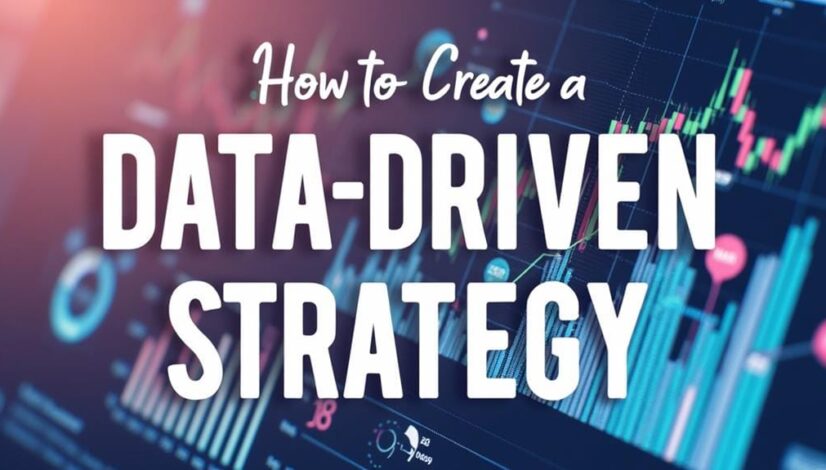How to Create a Data-Driven Marketing Strategy
To create a data-driven marketing strategy, start by understanding your target audience through demographic segmentation and customer personas. Collect and analyze relevant data from diverse sources to identify key performance metrics that align with business goals. Set clear, measurable objectives to guide your campaigns. Develop tailored marketing strategies based on competitive analysis and customer insights. Implement these strategies and continuously monitor their performance against established KPIs. Finally, optimize your approach using behavioral insights and feedback loops to remain agile and effective. For a thorough exploration of effective tactics, further insights await.
Key Takeaways
- Understand your target audience by creating customer personas and tailoring messaging based on demographic insights to foster engagement and loyalty.
- Collect relevant data from diverse sources, including customer feedback and analytics, to inform your marketing strategies and track campaign effectiveness.
- Set clear and measurable goals that align with business objectives to guide marketing efforts and evaluate performance effectively.
- Develop and implement targeted marketing strategies using competitive analysis, audience segmentation, and personalization techniques to resonate with your audience.
- Regularly optimize campaigns by analyzing customer behavior, leveraging feedback loops, and utilizing predictive modeling for continuous improvement and responsiveness.
Understand Your Target Audience

To effectively shape a data-driven marketing strategy, understanding your target audience is paramount. This comprehension is not merely about identifying who your customers are; it extends to cultivating detailed insights that can drive your marketing decisions. Establishing a clear picture of your audience requires meticulous demographic segmentation. By categorizing your potential customers based on characteristics such as age, gender, income, and geographic location, you can tailor your messaging to resonate deeply with specific groups.
Moreover, demographic segmentation serves as a foundation for developing robust customer personas. These personas act as semi-fictional representations of your ideal customers, aiding in visualizing their needs, behaviors, and pain points. Creating customer personas involves synthesizing information from your demographic segments and infusing it with qualitative insights, such as interests and values. This approach allows marketers to design personalized content and effective campaigns that speak directly to their audience's motivations.
The insights derived from demographic segmentation and customer personas empower organizations to align their marketing efforts with consumer expectations. By implementing targeted strategies based on well-defined personas, businesses can enhance engagement and drive conversions.
In a marketplace where freedom of choice reigns, understanding your audience liberates marketers from guesswork, enabling them to construct narratives that capture attention and cultivate loyalty.
Fundamentally, a data-driven approach to comprehending your target audience is not just beneficial; it is essential for fostering lasting relationships and achieving measurable results in a competitive landscape.
Collect Relevant Data
To develop a robust data-driven marketing strategy, it is essential to identify key metrics that align with business objectives.
Utilizing a variety of data sources, such as customer feedback, web analytics, and market research, will enhance the quality and relevance of the information gathered.
This targeted approach not only informs decision-making but also drives measurable results.
Identify Key Metrics
Regularly identifying key metrics is essential for developing an effective data-driven marketing strategy. This process allows marketers to track progress, assess campaign performance, and ultimately drive growth.
Focusing on specific metrics aids in understanding user behavior and optimizing marketing initiatives. Here are three key metrics to evaluate:
- Conversion Rates: Measure how well your campaigns facilitate lead generation and move prospects through the sales funnel. Analyzing conversion rates provides insights into areas for improvement, enhancing your ROI calculation efforts.
- Engagement Metrics: Track user interaction with your brand across various channels. High engagement rates often indicate strong brand awareness and effective market segmentation strategies, connecting you more deeply with your audience.
- Customer Retention: Understanding how well you retain existing customers can reveal gaps in your marketing approach. Focusing on retention rates helps inform strategies aimed at fostering loyalty and maintaining long-term relationships.
Utilize Data Sources
Effective marketing strategies are built on a foundation of relevant data collected from diverse sources. By integrating various data sets, marketers can conduct competitive analysis to uncover insights that drive informed decision-making.
A robust approach to customer segmentation allows brands to tailor their strategies to distinct audience personas, enhancing engagement and conversion rates.
Utilizing data visualization tools transforms complex data into comprehensible graphics, facilitating the interpretation of market trends. Strategic use of predictive analytics empowers marketers to forecast future behaviors and preferences, allowing for proactive campaign adjustments.
Moreover, real-time tracking of user interactions provides immediate feedback, guaranteeing marketing efforts remain agile and responsive to shifting consumer demands.
To maintain the integrity of this data-driven approach, implementing strong data governance practices is essential. This involves establishing protocols that guarantee data accuracy, privacy, and compliance.
By leveraging these data sources systematically, businesses can cultivate strategies that not only resonate with their target audience but also foster sustainable growth.
In this dynamic market landscape, the ability to harness and analyze data becomes an indispensable asset for those seeking freedom to innovate and excel.
Analyze Data Effectively

To develop a successful data-driven marketing strategy, organizations must prioritize the identification of key metrics that align with their goals.
Utilizing appropriate analytical tools enhances the ability to interpret these metrics effectively, allowing for informed decision-making.
This process not only clarifies performance insights but also drives strategic improvements in marketing initiatives.
Identifying Key Metrics
In the domain of data-driven marketing, identifying key metrics serves as the foundation for informed decision-making and strategic growth.
These metrics provide insights into customer behavior, helping marketers optimize their strategies and enhance performance.
To effectively identify and utilize key metrics, consider the following:
- Conversion Rates: Measure the percentage of users who complete a desired action, such as making a purchase or signing up for a newsletter. Monitoring these rates helps gauge channel effectiveness.
- Engagement Metrics: Track how customers interact with your content through likes, shares, and comments. High engagement rates can indicate strong customer interest and support the assessment of marketing ROI.
- A/B Testing Results: Implement variations in campaigns to identify which versions resonate more with your audience. This data-driven approach supports continuous improvement and allows for better alignment with performance benchmarks.
Tools for Analysis
Analyzing data requires the right tools to turn insights into actionable strategies. Robust data visualization tools allow marketers to represent complex information clearly, facilitating quick comprehension and strategic decision-making.
By leveraging predictive analytics, businesses can anticipate trends and customer behaviors, ensuring that marketing efforts remain proactive rather than reactive.
Segmentation tools play an essential role in understanding distinct audience groups, enabling tailored messaging that resonates powerfully with various demographics. A/B testing further refines marketing strategies by allowing marketers to compare different approaches to determine the most effective tactics for driving engagement and conversions.
The customer journey is best mapped through marketing automation platforms that streamline communication across channels and improve overall customer experience. Reporting dashboards provide snapshots of performance metrics, making it easier to gauge success and iterate strategies effectively.
Competitive analysis tools assist in benchmarking performance against industry peers, ensuring that marketing strategies remain relevant and innovative.
Lastly, sentiment analysis and conversion tracking empower marketers to gauge customer attitudes and measure the effectiveness of campaigns. Collectively, these tools empower marketing professionals to harness data effectively, shaping strategies that liberate businesses to thrive in a dynamic marketplace.
Set Clear Goals
Establishing clear goals is essential for any data-driven marketing strategy, as it lays the foundation for measurement and assessment. Effective goal setting not only defines your objectives, but also establishes performance benchmarks that guide your marketing efforts.
Without clarity in this critical phase, you risk misalignment between strategy implementation and expected outcomes.
To create effective goals, consider the following:
- Specificity: Goals should be clearly defined and focused. Instead of vague aspirations like "increase sales," target a specific percentage increase or revenue figure within a set timeframe.
- Measurability: Establish quantifiable metrics to track progress. This allows for real-time performance evaluation, highlighting areas of success and identifying where adjustments are needed. For instance, aim to boost website traffic by 30% over three months, and utilize analytics tools to monitor your progress.
- Achievability: Set realistic goals that are grounded in data. Review historical performance to set benchmarks that are ambitious yet attainable. This approach supports sustained motivation and commitment from your team.
Develop Marketing Strategies

With clear goals in place, the next step involves developing targeted marketing strategies that align with your objectives. This process begins by conducting a thorough competitive analysis to understand market trends and identify gaps that your brand can exploit.
Leveraging insights from audience segmentation will help you tailor your messaging and content marketing efforts, guaranteeing that campaigns resonate with your ideal customers.
To enhance customer engagement, utilize digital channels effectively. A robust presence on social media, email, and websites can notably boost lead generation. Implementing personalization strategies will allow your brand to connect with customers on a deeper level, fostering loyalty and trust. This personalized approach not only enhances user experience but also positions your brand distinctly in the minds of consumers.
Incorporating data analytics into your campaign optimization efforts is vital. By measuring performance metrics, you can identify what resonates with your audience and what requires adjustment. This iterative process empowers you to fine-tune your strategies in real-time, increasing your chances of achieving desired outcomes.
Furthermore, aligning your content marketing with brand positioning will guarantee consistency across all platforms. Consistent messaging amplifies brand recognition and reinforces your company's values.
Implement and Monitor
After developing targeted marketing strategies, the next vital step is to implement and monitor these initiatives effectively. This phase is significant, as it translates strategic concepts into actionable results that can propel your organization toward its goals. Implementing your strategies involves aligning your team, deploying resources, and executing the marketing campaigns with precision.
To guarantee success in this phase, consider the following key elements:
- Establish KPIs: Define clear key performance indicators (KPIs) that align with your objectives. These metrics will guide your monitoring efforts and help you gauge the effectiveness of your initiatives.
- Conduct Performance Reviews: Regularly assess the performance of your campaigns to understand what is working and what isn't. Analyzing performance data will allow you to make informed decisions and identify areas requiring enhancement or intervention.
- Implement Campaign Adjustments: Be prepared to adapt your strategies based on the insights gained from ongoing performance reviews. Whether it's reallocating budget, adjusting messaging, or refining target audiences, agile campaign adjustments are vital for optimizing outcomes.
Monitoring is not merely about observation; it necessitates a proactive stance. By actively engaging with the data and being responsive to market dynamics, you can guarantee your marketing endeavors remain relevant and effective while promoting a culture of continuous improvement.
Ultimately, the ability to implement and monitor effectively is fundamental to achieving a data-driven marketing strategy that supports your organization's freedom to innovate and grow.
Optimize Based on Insights

Regularly optimizing marketing efforts based on insights is essential for maintaining competitive advantage and enhancing campaign performance. Utilizing a framework of customer segmentation allows marketers to understand distinct groups within their audience, revealing the potential for targeted messaging that resonates.
Analyzing behavior patterns through sophisticated trend analysis provides the necessary context for identifying shifts in consumer preferences, which can swiftly inform strategy adjustments.
Incorporating feedback loops into your marketing processes is vital. These loops enable continuous evaluation of campaign performance, encouraging iterative improvements. By systematically reviewing data and response rates, businesses can fine-tune their efforts, ensuring responsiveness to changes in the market landscape.
Moreover, leveraging predictive modeling offers predictive insights about future customer behavior, enabling marketers to proactively adjust tactics before trends fully materialize. This foresight can be a game-changer in ensuring that marketing initiatives are timely and relevant.
Marketing automation plays a pivotal role in this optimization process, streamlining the execution of campaigns while ensuring that personalization is at the forefront. Through content personalization, marketers can deliver tailored experiences that foster deeper connections with customers, thereby increasing engagement and loyalty.
Ultimately, effective campaign optimization requires a commitment to data-driven decision-making. By diligently analyzing insights and adapting strategies accordingly, businesses can harness the full potential of their marketing efforts, creating meaningful impacts that drive growth while preserving the freedom and choices of their audience.
Frequently Asked Questions
What Tools Can I Use for Data Collection and Analysis?
To effectively collect and analyze data, leverage a combination of survey tools for direct feedback, analytics platforms for web behavior insights, and data visualization tools for interpreting complex datasets.
Implement customer segmentation strategies to tailor your marketing efforts. Utilize A/B testing to compare performance metrics, social listening for real-time insights, and performance tracking for campaign evaluation.
How Often Should I Review and Adjust My Marketing Strategy?
In the fast-paced world of marketing, the notion of reviewing your strategy as infrequently as once a decade is nothing short of a marketing faux pas!
A proactive frequency assessment is essential; ideally, quarterly reviews should be conducted to guarantee your strategy remains flexible and responsive to changing market dynamics.
This not only empowers your marketing efforts but also fosters a sense of freedom, allowing your team to pivot decisively based on real-time insights.
Can Small Businesses Use Data-Driven Marketing Effectively?
Yes, small businesses can effectively leverage data-driven marketing to enhance their operations.
By employing customer segmentation techniques, these businesses can identify distinct audience groups, allowing for tailored marketing efforts.
Additionally, marketing personalization fosters deeper connections with customers, greatly boosting engagement and loyalty.
Utilizing accessible data analytics tools, small businesses can implement strategies that maximize results and drive growth, all while preserving the autonomy and uniqueness that characterize their brand.
What Are Common Mistakes to Avoid in Data-Driven Marketing?
In the pursuit of marketing excellence, one must tread carefully, as pitfalls abound. Over-relying on data can obscure valuable insights, while neglecting context fosters misinterpretation of metrics.
Furthermore, ignoring audience nuances may lead to inadequate training and execution failures. Lacking integration of diverse data sources compromises strategy, and dismissing qualitative feedback undermines depth.
Additionally, failing segmentation can render campaigns ineffective. Avoiding these common missteps is essential for achieving true data-driven marketing success.
How Do I Ensure Data Privacy and Compliance in Marketing?
Ensuring data privacy and compliance in marketing necessitates a thorough approach to data protection. Organizations must familiarize themselves with compliance regulations, such as GDPR or CCPA, and implement robust policies for data handling.
Regular audits and employee training are essential to maintain awareness and adherence to these regulations. Additionally, transparency with consumers about data usage can cultivate trust, ultimately fostering more effective marketing strategies while prioritizing individual freedoms and data integrity.
Conclusion
In crafting a data-driven marketing strategy, a meticulous orchestration of insights transforms mere numbers into a vibrant tapestry of consumer understanding. Each step, from comprehending the audience to implementing tailored strategies, serves as a brushstroke that creates a thorough portrait of market dynamics. By continuously optimizing based on real-time insights, organizations can navigate the ever-evolving landscape of consumer behavior, ensuring that marketing efforts resonate like a well-composed symphony, ultimately leading to sustained engagement and growth.




